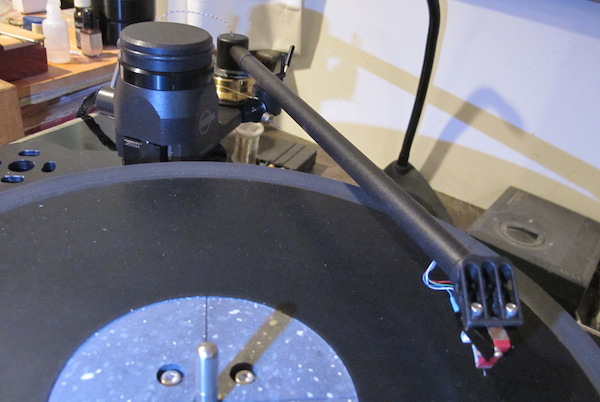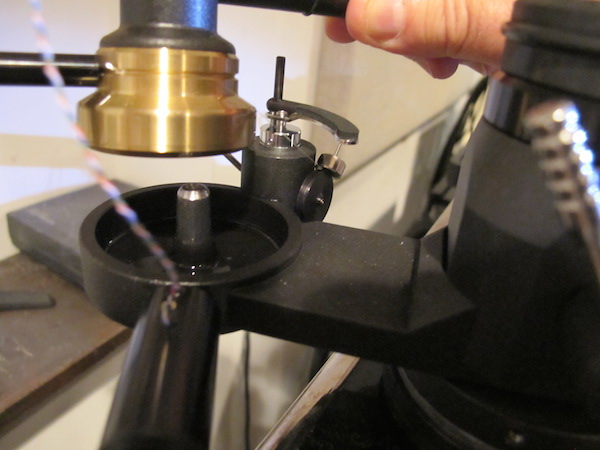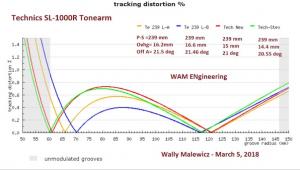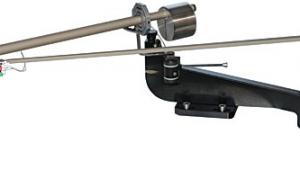Kuzma Stogi S SE 12" Tonearm with VTA Tower Is a Serious Overachiever
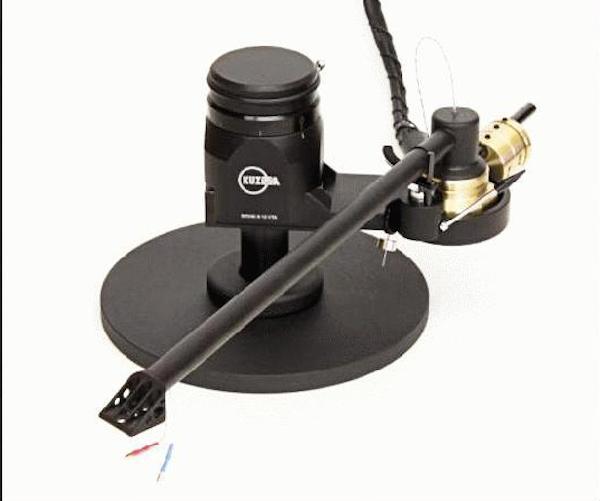
Though the Stogi S arm (9” version) is almost always paired with the Stabi S “pipebomb” turntable (a fine sounding ‘table and one of the greatest turntable values IMO) it is also available separately either with or without the VTA tower.
The 9” version without the VTA tower at under $1500 is also an outstanding value. The 12” Stogi S minus the tower costs $2665, which means the convenience of “VTA on the fly” adjustability is yours for an additional $485. I regard that as well worth the difference, but the VTA tower (identical to the 4 Point’s) brings an additional and in some situations a critical benefit: it allows you to use a 12” tone arm on a ‘table designed for a 9” one.
That’s possible because the VTA post is the mounting point. The actual pivot point is cantilevered from the tower and can be positioned as required to meet the considerable 291mm spindle to pivot distance.
The spindle to VTA post distance is spec’d at 212mm, which is far shorter than, for instance than that of an 8.7” Rega arm, which is spec’d at 221.7mm pivot to spindle distance.
However, while you could “drop in” a 12” StogiS VTA arm you couldn’t “drop in” a standard 12” Stogi S requiring the same 300mm pivot to spindle distance because minus the VTA tower the mount point is directly below the pivot point.
Credit Where Credit Is Due
The Stogi S is an ingeniously designed unipivot tonearm consisting of a cup in the center of which is a unipivot bearing post. A heavy brass bell, flattened on its bottom, containing the unipivot bearing point sits atop the bearing post within the bearing cup, which contains a pool of silicone damping fluid.
The brass bell’s mass thus sits considerably below the system’s center of gravity contributing to its stability, which is further enhanced by the silicone that contacts the brass bell’s bottom. The underslung counterweight further enhances the system’s stability.
Credit for this design, effectively copied here by Mr. Kuzma and in a dual pivot design by Basis Audio’s A.J. Conti, goes to Spiral Groove’s Allen Perkins who produced the original back in the 1990s as the RPM 2 tone arm. However, that arm had three further enhancements that none of the copies manage: the threaded bearing post on that arm is sunk into the turntable’s arm board, making a direct mechanical ground. It is threaded in and locked in place with the jeweled bearing cup placed in the plane of play at stylus height. One obvious benefit of that is that it minimizes “warp wow”. What’s more, with VTA set via a threaded screw set in the pivot housing bell, changing VTA raises and lowers the back of the arm without changing the pre-set plane of play. Now that’s design genius! And while I’m at it, if you look at the RPM turntable’s industrial design, you’ll see that it’s been widely copied as well.
Execution is as Important as Design
It’s one thing to take inspiration from another’s design. It’s another to execute and here the expert machinist Franc Kuzma manages brilliantly though his arms lack “bling”. The Stogi S VTA is elegant in design though cosmetically it’s somewhat lacking. Personally, I like the understated looks.
Rigidity is especially critical in a 12” arm. The unique, ultra-rigid square head shell is machined from a solid aluminum block and contains rigidity enhancing vertical struts. The brass bell—in fact every part of this arm—is machined from a block of solid metal.
Set-Up
In my situation, installing the Stogi S was as easy as loosening three grub screws, lifting out the 4 Point’s VTA base and replacing it with the Stogi S’s.
The next step is to fix the height of the VTA post that you’ve just inserted into the mounting base. After you’ve made sure that the VTA tower is set midway in its ±5mm vertical travel, you manually raise the tower post so that the top of the bearing post within the bearing cup lines up with the top of the platter so the bearing is in the plane of record play, and then you tighten the grub screws on the mounting base, but of course you’ve yet to set the pivot to spindle distance, which requires you to loosen the grub screws you’ve just tightened. Doing so would lose the height setting so Kuzma supplied a thin plastic ring located at the top of the post you’ve just locked in place.
You loosen the small ring’s grub screws and the ring drops down and contacts the arm base. You tighten the grub screws, fixing the ring, and loosen the grub screws holding the tower in place. Thus the tower height you’ve set is preserved, but you can now rotate the assemblage to accurately set the specified pivot to spindle distance. This is identical to the 4 Point set-up.
Setting up the Stogi S would have been far easier were it not for Mr. Kuzma’s terrible instructions. This has been an easily solvable problem for many years now and there are no excuses. I don’t understand why this can’t be fixed.
(The American importer informs me that in fact the instruction manual that you can find on Kuzma's website has been corrected for the issue I write about below. My sample was an older iteration with the original manual).
For instance—and this is the worst example of what I’m writing about—on page 4 it says the distance from the spindle (here referred to as “the center of the record”) to the pivot point (here referred to as “the center of the horizontal bearing”) is 300mm. So set, I was unable to correctly set the overhang. The stylus didn’t sit far enough forward, even with the cartridge fully forward in the head shell.
It drove me bonkers until I looked on page 3 where the pivot to spindle distance was specified at 291mm, not 300mm. Now it all made sense and proper alignment was possible. But how long has this arm been in production with that mistake?
Another example was in the azimuth adjustment instructions, which like the VPI arm, is, according to the instructions, set by rotating the counterweight. However, when I looked more closely at the main brass counterweight I noticed it had a large threaded hole in its side, which if it contained a screw could be used to adjust azimuth without rotating the weight.
A call to Elite Audio Video Distribution, the American importer, confirmed that the azimuth setting had been changed to the screw-in, screw-out method (Elite’s website leaves much to be desired as well—if you click on Kuzma arm technical details you get “n/a”). Unfortunately the instructions had not been changed, nor had the screws been inserted into the counterweight (Kuzma supplies two large ones and one small one for fine VTA adjustment).
In the big picture these are minor gripes and now that you know about the issues you won’t have the problems. You have been forewarned!
So, with the Lyra Etna installed and VTF, overhang, VTA/SRA, azimuth and anti-skating set (the 12” arm, with its minimal angle offset requires very little anti-skating force), it was time to play some tunes!
However, keep in mind that a unipivot arm’s stability results from lowering the center of gravity well below the pivot point. Doing so produces a stable balance condition where the arm, when moved from its resting point (on the record) will want to return there and thus generates a down force. So the further from the rest point you measure VTF the greater will be the discrepancy between what you measure and what’s actually the VTF at the record surface.
In other words, if you measure 2.0g well above the record surface, it will be considerably lower at the record surface, so be sure to compensate by setting the actual tracking force somewhat higher than you intend for it to be.
How much higher? Let’s say you’re using the Audio Additives stylus pressure gauge, which raises the stylus from the platter surface. Try to measure the VTF at the platter height by creating a platform next to the platter upon which you place the gauge so that the measuring platform is at platter height. Then repeat with the gauge on the platter. You’ll probably note a +.25g reading with the gauge on the platter (as the arm seeks to reach its resting point). So if you want 2g and you’re measuring on the platter, set it for 2.25 and you’ll really be tracking at 2 grams.
Stogi S SE 12” Tonearm w/VTA Tower Sound
I have a friend who bought a Kuzma 4 Point after reading my review. He ended up selling it. He told me that he understood what I liked about it and were he a reviewer he’d have kept it. What I like about the 4 Point is what I consider to be its tonal neutrality. I don’t want the arm to be adding ‘sweetness’ or warmth or anything. I want neutrality so I can better assess cartridge sound. Transducers are the most colored link in the chain (though both loudspeakers and cartridges have improved dramatically over the past decade in my opinion).
I’m hard pressed to note tonal differences between the 4 Point and the Stogi S, though I did not some other sonic differences.
There are those unipivot skeptics who think a single point arm results in less stability than does a fixed gimbal arm but my experience tells me otherwise (assuming it’s been properly designed). This arm proved to be very stable. Lower the stylus onto the record and it “sticks” its landing and produces a minimalist “pop” analogous to when I diver perfectly hits the water barely generating a splash.
The Lyra Etna loved this arm. A label sent me a test pressing of what it said was an impossible to track percussion record. It causes “depth charges” on their turntable. The Etna on the 4 Point tracked it without incident. But so did the Stogi S.
Better than just flawless tracking, the combo produced solid, “meaty” drum thwacks and impressive three-dimensionality that rivaled the 4 Point’s performance and in some ways produced what seemed like more pronounced lower midrange solidity and weight—but as I’ve not yet switched back that claim is on hold.
During this review a new Electric Recording Company release arrived: solo piano music of Debussy (“Estampes” and “Préludes, Livre 1”) played by Henriette Faure (ERC006) originally released on the French Ducretet Thompson label in 1961 (an original pressing of which sold this year on Ebay for $1540).
This is not an easy to track record, having some brutally intense percussive crescendos. Piano recordings are notoriously difficult to track to begin with. I heard no break-ups—not even hints of the stylus mistracking.
The Etna/Stogi S combo produced ultra-stable images on a wide and especially deep soundstage, with the forward part of the stage on familiar recordings setting up somewhat back from what the 4 Point produced and perhaps with not quite the same profusion of air. Perhaps reducing the damping fluid volume might have increased the air, but I chose not to because the results as set were so solid and so convincing, I liked it very much as it was.
The piano sounded rich or hard depending on how much force Ms. Faure was applying to the keys, which is how it’s supposed to sound. The instrument’s harmonic structure was also well-presented, with the percussive and resonant qualities nicely structured from attack to decay. It sounded like a piano—woody and wire-y and not at all softened for comfort at the expense of honesty.
That goes equally for the MPS six LP Oscar Peterson box set Exclusively For My Friends cut from the original analog master tapes and sounding superbly intimate (it was recorded in a fan’s living room). Oscar could hit those keys hard and no doubt this set will produce tracking problems for lesser cartridges and arms. The Etna/ Stogi S had no trouble.
Late one evening I played through entire double LP The Beatles (U.K. Apple PCS 7067/8 #0441033)—yes even “Revolution #9, which was way ahead of its time— and greatly appreciated both the background quiet and especially the image solidity and deep, tight “grippy” bass. Lennon singing “Julia” was particularly memorable because of the vocal image solidity and three dimensionality that seemed to bring John back to life. That made me pull out “#9 Dream” from a U.K. pressing of Walls and Bridges”, which has always been a magical track. The older I get, the deeper that track goes.
In terms of frequency extension, the Stogi S doesn’t quite plumb the depths like the 4 Point does, nor is its top end quite as airy and crystalline-pure but it’s close and probably with some damping fluid readjustment (on both arms), the two could be made to sound Anyway, the point is, this was an arm costing less than half the cost of the reference 4 Point, set up for review, but as sometimes happens, it sufficiently impressed to carve out a life of its own on my turntable that led to long evenings of musical rediscovery.
Twelve Inches Three Too Many?
Take your mind out of the gutter. The advantages over a 9” arm are theoretically less angular tracking error and thus lower distortion as well as the need for less anti-skating force due to the reduced offset angle. The disadvantages? If you don’t perfectly set overhang and zenith angle, the additional distance from the pivot point magnifies your mistakes. In addition, the longer the arm, the more difficult it is to maintain rigidity and the increased moment of inertia means the arm’s response to warps is slower and more cumbersome.
Even with all of those issues properly dealt with both in terms of set-up and design, does the extra length buy you improved sonics? In my experience a properly set up 9” arm sounds equally good as a properly set up 12” arm. I don’t hear the measurably lower angular distortion but then perhaps it’s because I’m not listening for it. The point is, it’s your choice and your decision to make. What’s particularly great about this arm is that you can have a 12” tone arm mounted on a ‘table intended to accommodate only a 9” arm.
Conclusion
The Kuzma Stogi S SE 12” with VTA tower wired with Crystal silver/gold alloy cable is a mechanically solid, well-designed and engineered tone arm. It’s wired straight through from cartridge clips to RCA bullet plugs (a generous length). Getting the most out of it requires meticulous set-up in all parameters and as with any 12” arm, overhang and zenith angle errors will be magnified. As with any unipivot arm, setting azimuth is critical as unlike fixed gimbal arms, there’s no fixed setting where at least cantilever perpendicularity to the record surface is assured. On the other hand unlike some fixed gimbal arms where you can’t, here you can adjust azimuth and maximize channel separation.
The Stogi S combines relative simplicity with complete adjustability. It can handle a wide range of cartridge weights up to 15 grams. It allows for robust mechanical damping and so doesn’t wobble on its way down to the record surface.
While it doesn’t have the 4 Point’s dynamic capabilities, it comes reasonably close and it seems to have a unique and pleasing weight and stability that helps to produce solid, stable imaging that makes possible long term listening enjoyment.
If you are in the market for a circa $3000 tone arm, the Kuzma Stogi S SE 12” with VTA tower should be at the top of your list. $3000 is a great deal of money, but it puts within reach of many an outstanding tonearm.
Specifications
Effective length: 304.8mm
Mounting distance: 212mm
Distance from spindle to bearing:291mm
Offset angle: 17.8 degrees
Effective mass: 13 grams
